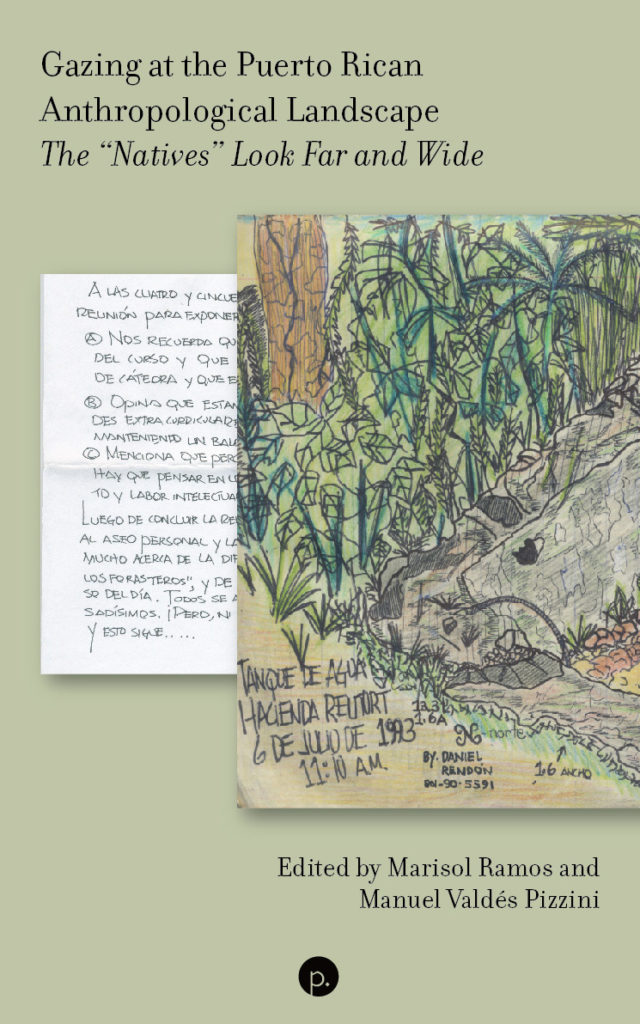Before the World War II, most anthropological research in Puerto Rico was led by US anthropologists. The most famous project, The People of Puerto Rico, was directed by American anthropologist Julian Steward and launched the career of renowned scholars such as Sidney Mintz and Eric Wolf. Gazing at the Puerto Rican Anthropological Landscape aims to delineate the development of the post-WWII anthropological field in Puerto Rico by Puerto Rican anthropologists, the so-called “native” anthropologists. The contributors to Gazing at the Puerto Rican Anthropological Landscape deploy the term “native” somewhat ironically, but they also know that who they are affects their positionality vis-à-vis their research subjects. Thus, they retain the term to spark a conversation addressing the complicated feelings that such labels still evoke among non-mainstream anthropologists
Gazing at the Puerto Rican Anthropological Landscape purposely avoids making Puerto Rico and Puerto Ricans a problem to study and instead focuses on a wide variety of epistemological and methodological questions related to the study of Puerto Rico and Puerto Ricans by “native” anthropologists within local, regional, and global spheres. We posit that the Puerto Rican anthropological landscape transcends the confines of the island of Puerto Rico to encompass its connection and engagement with the larger world, and that it is not limited to the inhabitants of the island of Puerto Rico but embraces members of its diaspora, as well as other groups and ethnicities. On that note, this book seeks to reflect critically on how the academic field of anthropology (research and teaching) in Puerto Rico has evolved, post-WWII, in various engagements with the current debates of contemporary anthropology — theoretical, methodological, socio-cultural, political, and otherwise.
About the Editors
 Marisol Ramos is Librarian for Chicana/o Studies, Latin American and Iberian Studies, and Spanish & Portuguese at the University of California, Santa Barbara. She has been part of several writing projects, from coauthoring a book about creating an archival program with limited resources to collaborating on several book chapters about access to cultural heritage archives to issues of diversity and inclusion in libraries and archives. Her publications include the co-authored book, Building a Successful Archival Programme: A Practical Approach (Chandos, 2006) and the co-authored book chapters “Puerto Rico’s Archival Traditions in the Context of Colonialism,” in Decolonizing the Caribbean Record: An Archives Reader (Litwin Books, 2018), and “Identity and Inclusion in the Archives: Challenges of Documenting One’s Own Community,” in Through the Archival Looking Glass: A Reader on Diversity and Inclusion (Society of American Archivists, 2014). Her other research interest is Spanish literature in 19th-century Puerto Rico. In this area she has published the article “La visión de la nación puertorriqueña dentro del marco del romanticismo, el cosmopolitismo y la modernidad de Alejandro Tapia y Rivera” in Caribbean Studies in 2018 and in 2024 she obtained her Ph. in Spanish literature from the University of Connecticut with the dissertation “La nación del porvenir: La literatura fundacional cosmopolita de Alejandro Tapia y Rivera (1823-1882).”
Marisol Ramos is Librarian for Chicana/o Studies, Latin American and Iberian Studies, and Spanish & Portuguese at the University of California, Santa Barbara. She has been part of several writing projects, from coauthoring a book about creating an archival program with limited resources to collaborating on several book chapters about access to cultural heritage archives to issues of diversity and inclusion in libraries and archives. Her publications include the co-authored book, Building a Successful Archival Programme: A Practical Approach (Chandos, 2006) and the co-authored book chapters “Puerto Rico’s Archival Traditions in the Context of Colonialism,” in Decolonizing the Caribbean Record: An Archives Reader (Litwin Books, 2018), and “Identity and Inclusion in the Archives: Challenges of Documenting One’s Own Community,” in Through the Archival Looking Glass: A Reader on Diversity and Inclusion (Society of American Archivists, 2014). Her other research interest is Spanish literature in 19th-century Puerto Rico. In this area she has published the article “La visión de la nación puertorriqueña dentro del marco del romanticismo, el cosmopolitismo y la modernidad de Alejandro Tapia y Rivera” in Caribbean Studies in 2018 and in 2024 she obtained her Ph. in Spanish literature from the University of Connecticut with the dissertation “La nación del porvenir: La literatura fundacional cosmopolita de Alejandro Tapia y Rivera (1823-1882).”
 Manuel Valdés Pizzini is Professor Emeritus (2023) in the Department of Anthropology and Sociology at the University of Puerto Rico in Mayagüez (UPRM). He is currently the Coordinator of the Interdisciplinary Center for Coastal Studies (Centro Interdisciplinario de Estudios del Litoral, CIEL) at UPRM. His research focuses on the human-ecosystem interface, with special attention to the use of coastal and marine resources, species, and habitats within socio-ecological and historical perspectives. Valdés-Pizzini is the author and co-author of several articles on Local Ecological Knowledge (LEK), marine protected areas, coastal communities, fisheries, and the history of fishing gear. His research interests also extend to the use of tropical forests from an ethnographic and historical perspective. He is the co-author (with Michelle T. Schärer-Umpierre) of People, Habitats, Species, and Governance: An Assessment of the Social-ecological System of La Parguera, Puerto Rico (Sea Grant, 2014) and author of Una mirada al mundo de los pescadores en Puerto Rico: Una mirada global (Sea Grant, 2011). Other publications include La transformación del paisaje puertorriqueño y la disciplina del Cuerpo Civil de Conservación, 1933–1942 (Centro de Investigaciones Sociales, 2011, with Michael González and José Eduardo Martínez) and Fishers at Work, Workers at Sea: Puerto Rican Journey Thru Labor and Refuge (Temple, 2002, with David Griffith).
Manuel Valdés Pizzini is Professor Emeritus (2023) in the Department of Anthropology and Sociology at the University of Puerto Rico in Mayagüez (UPRM). He is currently the Coordinator of the Interdisciplinary Center for Coastal Studies (Centro Interdisciplinario de Estudios del Litoral, CIEL) at UPRM. His research focuses on the human-ecosystem interface, with special attention to the use of coastal and marine resources, species, and habitats within socio-ecological and historical perspectives. Valdés-Pizzini is the author and co-author of several articles on Local Ecological Knowledge (LEK), marine protected areas, coastal communities, fisheries, and the history of fishing gear. His research interests also extend to the use of tropical forests from an ethnographic and historical perspective. He is the co-author (with Michelle T. Schärer-Umpierre) of People, Habitats, Species, and Governance: An Assessment of the Social-ecological System of La Parguera, Puerto Rico (Sea Grant, 2014) and author of Una mirada al mundo de los pescadores en Puerto Rico: Una mirada global (Sea Grant, 2011). Other publications include La transformación del paisaje puertorriqueño y la disciplina del Cuerpo Civil de Conservación, 1933–1942 (Centro de Investigaciones Sociales, 2011, with Michael González and José Eduardo Martínez) and Fishers at Work, Workers at Sea: Puerto Rican Journey Thru Labor and Refuge (Temple, 2002, with David Griffith).






